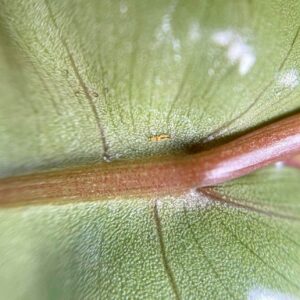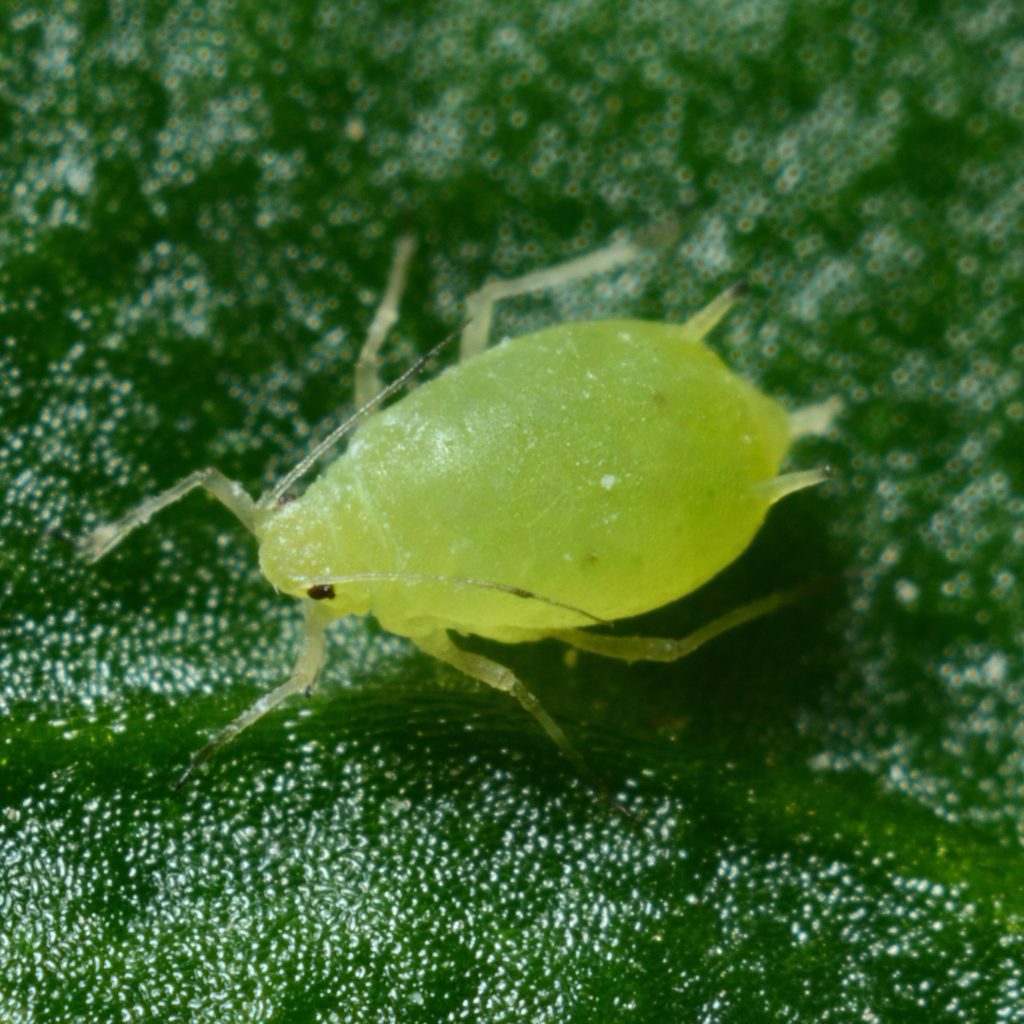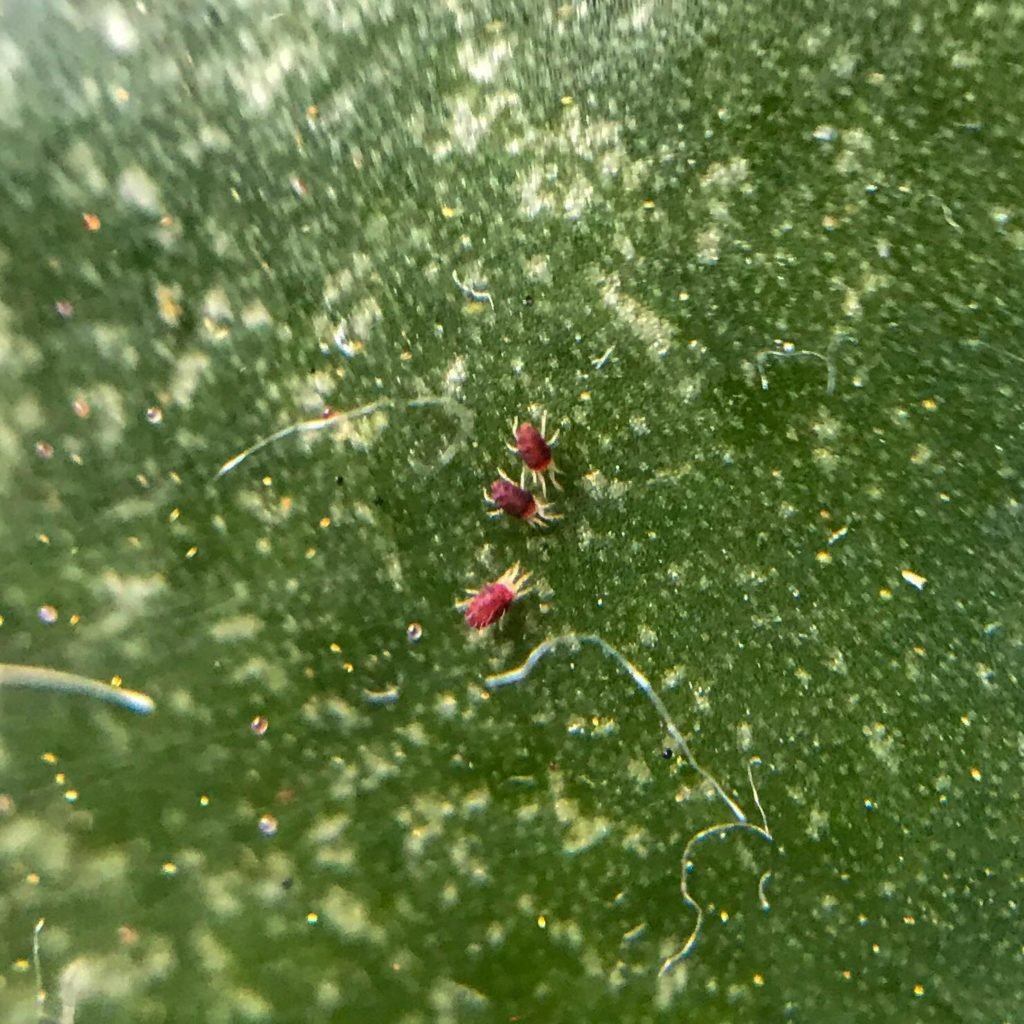Thrips are definitely one of the most annoying pests you can encounter on your houseplants. They’re very tiny, black insects that suck the juices out of the leaves, causing unwanted damage to your plants. Thrips can multiply very quickly and they can fly, which makes getting rid of them that little bit harder.
In this article we’ll explore how to identify thrips along with methods for treating them on indoor plants. We’ve also got a short video below showing how we’ve treated thrips on this Monstera Albo.
Thrips Quick Overview

| Identification | Long, slender body. Commonly black in colour but can be brown, white and greenish yellow. |
| Symptoms | Deformed growth, brown dots on foliage and faded, pale in colour, splotchy leaves. |
| Treatment | Insecticidal soap, neem oil, sticky traps and rinsing the plant. |
What are Thrips?
Thrips are small, slender insects that suck the juices out of the leaves, stems, buds and flowers. They are generally under a quarter-inch in length when they are adults. Common colours for the adults are brown, black or yellow and when in the larvae stage, they are a yellow, greenish colour.
Adult Thrips also have little wings, however, they aren’t very strong flyers. Thrip eggs are so small, they’re barely visible to spot with the naked eye so seeing them will be nearly impossible. Since they are so small, they are much harder to spot on your plants. They are generally found on the under side of the leaves and in new growth.
Thrips Life Cycle
Knowing the life cycle of thrips is important before trying to treat them. There are three stages of a thrips life cycle and that is; eggs, nymphs (baby thrips) and adults. When in the correct conditions, they can multiply very quickly with the eggs turning to adults within 2 weeks. Adult thrips will only live for about a month but there can be multiple generations going at the same time.
Female thrips can reproduce asexually which means they don’t need a male to multiply. Females will eat out a hollow in plant matter to lay her eggs in so that they’re protected from potential predators and weather conditions. When they hatch, the food source is already there for them.
Where do Thrips come from?
Thrips can come from plants that have been outside or new plants that have been bought home from a nursery. They can even be on veggies or flowers that you’ve bought in from outside. Since the adults are so tiny and have wings, it’s possible that they could’ve flown in from outside through a screen door or window.
To avoid starting any unwanted pest infestations, you should isolate and check new plants for pests before you put them in with your collection. Always check the underside of the leaves, stems and new growth for any unwanted pests.
Damage caused by Thrips
Faded or dirty looking leaves is usually the first sign of damage caused by Thrips. The foliage will start off by going a greyish colour before going brown as it starts to die. A mature, healthy house plant will be more likely to survive a thrip infestation rather than a smaller or weaker houseplant so getting onto treating thrips straight away is important.
Not only is a thrip infestation annoying to get rid of, they also make the new foliage look terrible. They can also stunt growth. Some other common symptoms that your plant may have thrips is:
- Brown dots on the foliage
- Faded, pale in colour, splotchy leaves
- Dying parts on the leaves
- Flower buds are deformed, falling off or not opening
- Dropping leaves
- Deformed new growth
If you notice any of your houseplants with any of these issues, it’s time to check them immediately in case of a thrip infestation.
How to get rid of Thrips
Just like other pests, you can eliminate thrips from your home and prevent them from coming back. However, these annoying little thrips can build an immunity to chemical pesticide treatments very quickly, making these little buggers even harder to get rid of. Luckily, using an organic treatment will work better at getting rid of thrips and not only will it be easier, you won’t have to use any nasty chemicals in your home.
Organic Control
The first thing you should do if you find thrips on one of your houseplants is to isolate it and check all surrounding plants. You should start treating your plants straight away. When treating Thrips, you will have to be persistent because one treatment won’t get rid of them straight away.
Rinse the Foliage
Rinsing the leaves of your affected plants will help to eliminate a lot of the insects before you start any treatments. Be careful that you don’t over-water your plants in the process.
Insecticidal Soap
Soap will kill the Thrips on contact. You can use a pre-mixed insecticidal soap from a store or you can make your own at home. To make it at home, mix 1tsp liquid soap with 1 litre of water.
When spraying for Thrips, be sure to spray directly on the affected leaves to kill the bugs. You should also spray all other leaves, new growth and the gaps where new growth grows from to eliminate any that may be hiding. Continue treatment every few days.
Neem Oil
One of the most popular insecticides people like to use is Neem oil. It’s a natural insecticide that will also discourage new thrip infestations on your plant. You can either buy a Neem oil concentrate that you mix with water or a Neem oil that is already ready to use.
Spray the leaves and stems of the plant with the solution and it will kill the Thrips on contact and others will die when they try to feed on the Neem oil covered leaves.
Beneficial Bugs
Beneficial bugs are also a great way to treat and prevent pest infestations. There are a few bugs that will eat Thrips and some other common pests like Spider Mites. Predatory Mites, Lady Bugs and Lacewings are just a few that will happily eat and get rid of Thrips for you.
Sticky Traps
Like mentioned earlier, when Thrips have reached the adult stage of their life, they are able to fly. Putting a sticky trap up near your plants will help to capture and reduce the adult thrips population.
Prevention
Thrips are definitely one of the worst pests to try and get rid of so once they’re gone, we want them gone for good. There are a few things you can do to try and prevent another thrip infestations. These are:
- Check new plants for pests or isolating new plants for up to a week.
- Check your plants regularly for pests.
- Trim off any dead or dying leaves.
- Wipe down leaves if you notice them getting dusty.
- Keeping your plants healthy. A healthy plant will be able to handle an infestation better than those that aren’t as happy.
- Isolate any plants that have pests.
Following these steps will help to avoid any unwanted pest infestations in the future.


